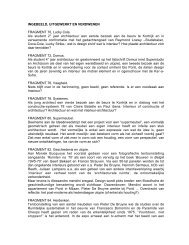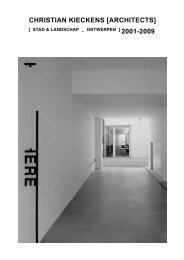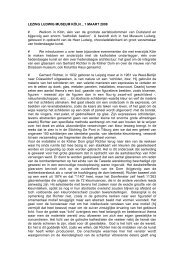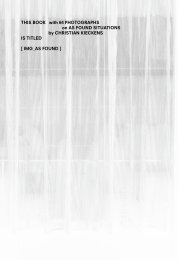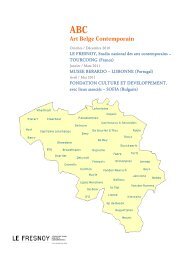download pdf - Christian Kieckens Architects
download pdf - Christian Kieckens Architects
download pdf - Christian Kieckens Architects
You also want an ePaper? Increase the reach of your titles
YUMPU automatically turns print PDFs into web optimized ePapers that Google loves.
ROLES / ARCHITECTONICSDENSITIES [DOWNTOWN AALST]or gone unnoticed. Objects such as words, whole or cut apart, and the frames,broken or not, displaced or not, are silhouetted within open square or rectangularframes that also frame views of the urban scene beyond. Thus the word is literallyinterpenetrated by the urban context. It is seen, read and interpreted within andagainst the background of a particular cityscape which inflects the word’s meaningas it, in its turn, addresses/annotates the environment in which it is immersed. Thisconceptual aggregate gives rise to new views that demand attention.Of the 50 books that Downsbrough has published in over 30 years, the one thatmost fascinates the architect is ROLES / ARCHITECTONICS (Internationaal Centrumvoor Structuuranalyse en Constructivisme, Brussels, 1983). It contains a text byDownsbrough interspersed with quotes by the writers A. Choisy, Alois Hirt, AndrzejTurowski and Paul Scheerbarts, and with photographs and montages by the artist.This book is remarkable not only for being the first one that Downsbrough publishedin Belgium but also because the text was originally presented as a conferenceand especially as it concerns a series of reflections which go beyond the purelyarchitectural. The interplay between word and image, between language and (in)sight plays the role of the architectonic, here.Like so many provincial towns which in recent times have transformed their historichearts to satisfy current interests, Aalst tends to disregard its origins. A case in point:Amylum, an industrial glucose manufacturer that occupies a site between a filled-inbend in the Dender River and the river’s canalized segment. Over time, awareness ofand opposition to the factory’s problematical presence in the town center has grown,and this against the dramatic and familiar leitmotif of demolishing built heritage thatno longer serves or pleases.Architecture deals with accepting and/or rejecting (in the attitude and thoughts:a state of doing and making ) as well as with considering conditions – the placewhere, the material used and the time when. It densifies and is consequential.Thus, architecture is distinguished from mere building and transforms necessity tooccasion.It follows that the authenticity of the industrial image—Amylum’s included—countermands esthetic purification. Along with the rest of the town’s industriallegacy, which dates back to the early days of printing, it is a part of the local collectivememory.The significance of this contested place is questioned in Downsbrough’s work“Here.” Moreover, “here”—Aalst and its essence— is considered not only as abstractsubject but also as concrete place. The gallery space in which the piece was shownbelongs to the town’s industrial heritage and served as a veritable embodiment ofthe exhibition’s theme.Densifying as a principle of architecture was demonstrated in a dual way. Whereasthe artist Downsbrough employs his hybrid language of text and image to examineand elucidate the city’s raison d’être, the architect questions the sense of the abruptstop of each city fragment which is loaded with a certain collectivity and that is pairedwith a notion of personal acceptance and/or rejection of the present densities of thecontemporary industrial heritage.Downsbrough’s room piece in Aalst’s Gallery S 65 (1996) presents a position that canAND / MAAR, OPAND / POUR, ETOCCUPIEDbe considered as a guide towards developing an actual meta-architectural projectinvolving architecture, city planning and art. In the book Densities (Downtown Aalst),2Raymond Balau writes: The haphazardness of the urban policies of the second partof the twentieth century lead to the reflection that the opening toward other logics isdesirable and maybe indispensable. This said, instigating an artist’s intervention aposteriori is one thing; the pre-requisition of a critical look, even before engaging inthe logistics of the project, is another thing. Without concessions, Downsbrough’swork reveals that which happens from architecture as discipline, and that by whichit is overlapped; he also shows to what extent the urban world is made of theseperipheral, terribly peremptory proliferations, and hence reveals the restraints ofarchitectural habits. The work on the urban theme is not uniquely an aspect of hispreoccupations. On the contrary, it is a conduct that crisscrosses the essence of hisproduction with an architectonic character, from the books to the projects for publicspaces, by declaring context the essential question. …. The connections betweenlevels of significances, as between reference regions, give a disenclosed resonanceto the underlying themes of his numerous sketches to the projects he distills fromthem. The genius loci in this part of Aalst, is not understandable without a very openperception of its spatio-temporal densities: Aalst is both the historical city of thebook as well a support city of modern industry. This composite memory invokes thecapacity of deciphering these diverse inscriptions, before any position is taken, forinstance within the limits of zoning regulations.“As a sound, the letter is a function of time, as a representation it is a function ofspace.“ (El Lissitzky).Commissioned by the City of Brussels and realized in 2003, Downsbrough’s twopartpiece bracketing Boulevard Emile Jacqmain frames the artifacts along thaturban span, most of which are recent buildings pretending to be architecture. Thisis a perspectival work in which seeing is linked with understanding and the seconddimension is linked to the third.This is exactly what this work is about: uniting essential things. Urban sounds arereflected in the letters, in the frames and the words, whether split or not. Readingthe words, we read the surroundings for clues to their meanings, scrutinizing thebuildings, traffic, people—all of the urban fabric that comes within the visual scope ofthe piece. A liberating force in the context of a twisted urban context, Downsbrough’swork points to content where none was noticed or thought to exist.The title of Downsbrough’s film Occupied contains a key to understanding the workitself. The word “occupied” is defined as “engaged,” “a place that is taken” and“inhabited.” This three-pronged single word fits in numerically with the film’s trio ofplan developments and levels of mental research. First, there is the direct meaning:the static formal character of the proximity of the image itself: the frame in which thesubject appears : entre parenthèses / SET.Next, there is the second layer, comprising the photographic/filmic aspect versus themobility of the image: going thuds from still to moving. This movement manifestsitself through a series of unfolding split images which undo this inherently staticcharacter: in addition to the symmetric plan – designated as the classic lay out byarchitectural history -, and the vertical symmetry – translated by exposures and madevisible in reflecting images – the unfolding mainly occurs in depth. And here lies the



